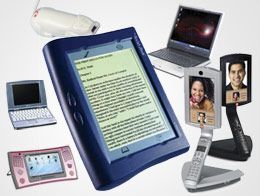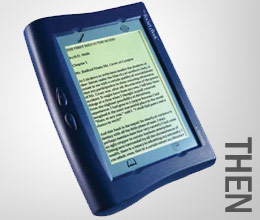Ahead of Its Time Tech
“Everything old is new again” is a mantra held in pop culture circles, but the saying can also be applied to mobile technology. While many innovations from years past have gone unnoticed (or outright flopped), the seeds they planted are now giving rise to a new crop of gadgets that build upon their positive attributes while attempting to avoid their pitfalls.
In that spirit, we’re scrutinizing some of the most hyped gear over the past 15 years and analyzing why they initially failed. Then we’ll take a look at today’s hottest mobile tech and demonstrate why these gadgets were simply ahead of their time.
Gadgets Featured:
1. :CueCat
2. Gemstar Rocket eBook
3. HP Jornada 820
4. Ojo Personal Video Phone
5. Pepper Pad
6. Sharp Actius RD3D
:CueCat
Year: 2000
What It Was: A USB barcode reader designed to scan codes in magazines and flyers and then direct users to web pages when it was connected to a computer.
Sign up to receive The Snapshot, a free special dispatch from Laptop Mag, in your inbox.
Why It Failed: Few readers were interested in whipping out a ridiculous cat-shaped scanner just to avoid typing URLs, and even fewer publications actually used the barcodes. However, Wired magazine supported the format for a time, and even sent all of its subscribers :CueCats to use.
Why It Was Important: This kitty was put to sleep long ago, but its legacy has nine lives; smart phone users have barcode scanning apps (such as ScanLife) that perform similar functions today. One of the most recent high-profile examples of this resurrected technology is Google Goggles, a visual search tool that lets users point their smart phones at an object and have the software launch Google search results based on the captured image.
“Augmented reality has been around for years,” said Dominique Bonte, practice director of telematics and navigation for ABI Research. “Nokia has a technology called Point & Find that lets you take a photo of a movie poster to receive theater locations and even purchase tickets. Consumers just don’t use it.”
Ahead of Its Time Tech Contents
1. :CueCat 2. Gemstar Rocket eBook
3. HP Jornada 820
4. Ojo Personal Video Phone
5. Pepper Pad
6. Sharp Actius RD3D
Gemstar Rocket eBook
Year: 1998
What It Was: The first dedicated eReader to garner attention from consumers. This early eReader let users read digital novels, keep notes in the margins, search passages, and bookmark pages. The built-in speaker also enabled the Rocket to read back selected passages.
Why It Failed: A lack of wireless connectivity, bestseller content, and sex appeal. It also didn’t help that the text quality paled in comparison to today’s E-Ink screens and that eBooks were both expensive (about $14 a pop) and completely locked down with digital rights management. Not even an appearance on Oprah could generate enough buzz for people to reach for their wallets.
Why It Was Important: The Gemstar Rocket eBook was the prototype for the Amazon Kindle, Barnes & Noble Nook, and a slew of other eReaders that have flooded the market in the past six months.
“The majority of eReaders that we see use ePaper, which is well suited for long-form reading and increased battery life,” said Ross Rubin, director of industry analysis for NPD Group. “There are also 3G—and soon to be 4G—connections that let consumers purchase books away from the PC. Plus, there’s far more content; when Amazon announced the Kindle, it said that it had over 90 percent of the The New York Times’ bestsellers.”
Ahead of Its Time Tech Contents
1. :CueCat 2. Gemstar Rocket eBook 3. HP Jornada 820
4. Ojo Personal Video Phone
5. Pepper Pad
6. Sharp Actius RD3D
HP Jornada 820
Year: 1998
What It Was: A mini–clamshell PC that ran Windows CE (as well as Handheld PC Professional Edition 3.0) and utilized a touchpad for desktop navigation. It featured a 640 x 480 display, and under the hood ran a 190-MHz Intel StrongArm RISC CPU, 16MB of RAM, and 16MB of ROM. It also boasted a lengthy battery life of 10 hours. As the operating system was stored in ROM, this machine also turned on instantly—no Splashtop required.
Why It Failed: The Jornada 820 lacked high-speed Internet connectivity, instead featuring “dial-up e-mail and graphical web browsing.” And because this device didn’t run full Windows, it wasn’t compatible with many popular programs. All information was stored in ROM, which meant that if the main and backup battery lost power, all information was lost. Fortunately, a CompactFlash slot was available to store vital data.
Current Chance of Technology’s Success: Definite. Netbooks, such as the Dell Inspiron Mini 10, continue to be the fastest growing PC segment. According to data culled by DisplaySearch, netbook makers are expected to move 39.7 million units in this year to the tune of $11.4 billion in revenue.
Ahead of Its Time Tech Contents
1. :CueCat
2. Gemstar Rocket eBook 3. HP Jornada 820 4. Ojo Personal Video Phone
5. Pepper Pad
6. Sharp Actius RD3D
Ojo Personal Video Phone
Year: 2004
What It Is: Specially designed landline phones that house a 7-inch (480 x 234 or 856 x 480) full-color display and an integrated speaker that allows gabbers to chat face-to-face, regardless of distance.
Why It Failed: With new and old models, you can only connect with an Ojo user if you have an Ojo phone, so purchasing a pair is essential. The other major stumbling block when Ojo first came to market was the original cost of a Personal Video Phone bundle: over $1,500. (They now start at a more reasonable $349 per phone.)
Current Chance of Technology’s Success: Uncertain. “Video chatting has been talked about for so long, but no one I know uses it,” said ABI Research’s Bonte. “Unless you’re specifically trying to show a person something on-screen, there’s really no need for it.”
Ahead of Its Time Tech Contents
1. :CueCat
2. Gemstar Rocket eBook
3. HP Jornada 820 4. Ojo Personal Video Phone 5. Pepper Pad
6. Sharp Actius RD3D
Pepper Pad
Year: 2004
What It Was: A $799 Linux-based internet pad with a 7-inch (800 x 480) display and built-in Wi-Fi connectivity that allowed users to surf the web, stream Internet radio, and instant message.
Why It Failed: Poor design and price. Not only was the Pepper Pad extremely unwieldy at 11.4 x 5.9 x 0.9 inches, but it featured a clunky split QWERTY keyboard design that positioned the letters and numbers both to the left and right of the screen. Plus, at just shy of $800, it rivaled the cost of more powerful full-sized notebooks.
Current Chance of Technology’s Success: Uncertain. MIDs, like the Pepper Pad, are tweener devices, which may cause them to be overlooked.
“How much room is there in the market for a device between the smart phone and the laptop?” asked NPD Group’s Rubin. “The MID and tablet have to go up against devices such as smart phones, which are always with a person, and laptops, which are slightly bigger but offer more power.”
Ahead of Its Time Tech Contents
1. :CueCat
2. Gemstar Rocket eBook
3. HP Jornada 820
4. Ojo Personal Video Phone 5. Pepper Pad 6. Sharp Actius RD3D
Sharp Actius RD3D
Year: 2003
What It Was: The first autostereo 3D notebook that displayed 3D images on its 15-inch screen without requiring the use of special glasses.
Why It Failed: The notebook’s performance slowed to a crawl when 3D visuals were activated, and the effects were noticeable only within a very narrow angle; if you moved your head a bit, the 3D image disappeared. Worse, the RD3D caused eye strain and cost an astronomical $3,299. The lack of compelling 3D content and apps would seal this machine’s fate as a mere novelty.
Current Chance of Technology’s Success: Fair. Acer and ASUS’ notebooks offer 3D experiences that are very close to what moviegoers are experiencing, though Nvidia’s pricier technology is more akin to what Avatar fans experienced in theaters. “Today’s 3D notebook require you to wear glasses, but the visuals are far superior to Sharp’s,” said NPD Group’s Rubin. “The question is whether or not consumers want to wear them for extended periods, especially gamers.”
Ahead of Its Time Tech Contents
1. :CueCat
2. Gemstar Rocket eBook
3. HP Jornada 820
4. Ojo Personal Video Phone
5. Pepper Pad 6. Sharp Actius RD3D
Jeffrey is a writer at Laptop Mag. His coverage includes chiefly laptop reviews, and he's tried some of the top brands out there, including Acer, Lenovo, MSI, Dell, and Sony. Outside of digging into laptop performance and features, Jeffrey covers things like peripherals and software.













